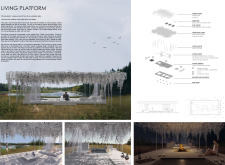5 key facts about this project
Spatial Organization and Functional Layout
The layout of the project is designed for optimal flow between various functional areas. Key components include [list important spaces such as entrance hall, communal areas, private sections, etc.]. The central circulation routes allow for easy movement, while strategically positioned windows provide views and natural light, contributing to the overall ambiance. The use of open spaces facilitates flexibility, enabling the building to adapt to varying user needs.
Sustainable Design Strategies
A defining aspect of this project is its commitment to sustainability. The architectural design incorporates passive solar heating, efficient insulation, and rainwater harvesting systems. Materials chosen for construction not only meet structural requirements but also enhance energy efficiency. The façade employs [describe materials, e.g., a combination of wood, metal, and glass], ensuring durability while maintaining an appealing exterior. Landscaping utilizes native plants, reducing water consumption and promoting biodiversity.
Innovative Use of Materials
The project showcases an innovative approach to material selection, blending modern elements with traditional craftsmanship. Concrete provides a robust structural foundation, while large glass panels facilitate transparency and connect the internal spaces with the exterior. Wood is incorporated in [describe specific areas, e.g., flooring or cladding], adding warmth and tactile quality. Metal elements enhance structural integrity as well as modern aesthetic appeal. This combination of materials supports the overall design philosophy, ensuring that each component complements the others.
The architectural plans and sections reveal a detailed understanding of the spatial dynamics and the interplay of light within the building. For a deeper understanding of the design concepts and detailed architectural elements, refer to the project presentation. This will provide insights into the architectural ideas that drive this project, illustrating its unique characteristics in a crowded landscape of modern architecture.























